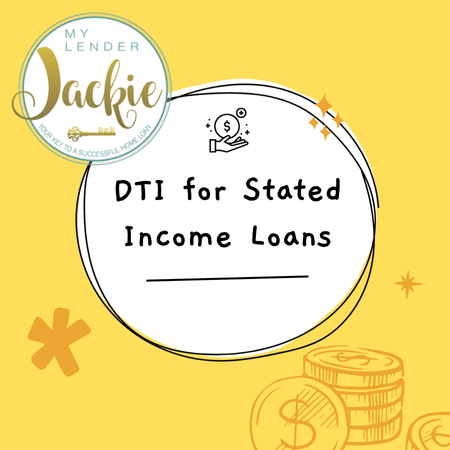We understand that the application process for a stated income loan can be complicated at first, especially if you’re more familiar with the conventional loan application process. If you want to learn more about the application process, we’re always available to answer your questions, so you can schedule a meeting with a loan officer today.
When applying for a traditional mortgage or a non-QM loan, one of the critical factors that lenders consider is the Debt-to-Income (DTI) ratio. This ratio plays a significant role in determining a your eligibility for a mortgage and the terms of the loan. Understanding what DTI is, how it is calculated, and why it is a crucial metic for us during the approval process can help you navigate the mortgage application process more effectively.
 What is DTI?
What is DTI?
The Debt-to-Income ratio is a measure that compares a borrower’s monthly debt payments to their gross monthly income. It is expressed as a percentage and serves as an indicator of a borrower’s ability to manage monthly payments and repay debts. The DTI ratio is divided into two components: the front-end ratio and the back-end ratio.
The front-end ratio, also known as the housing ratio, compares a borrower’s monthly housing expenses (including mortgage payments, property taxes, homeowners insurance, and homeowners association fees) to their gross monthly income.
The back-end ratio compares a borrower’s total monthly debt obligations (including housing expenses, credit card payments, car loans, student loans, and any other debt) to their gross monthly income.
How can I calculate my DTI?
If you want to calculate your own DTI, it’s pretty simple.
First, identify all monthly debt obligations. This includes the expected mortgage payment, property taxes, homeowners insurance, and any other monthly debt payments such as credit cards, car loans, student loans, and personal loans.
Next you will calculate your gross monthly income, which is your total income before taxes and other deductions. This can include salaries, wages, bonuses, and any other consistent income sources.
Then, you’ll simply calculate the ratios:
- Front-End Ratio: (Monthly Housing Expenses / Gross Monthly Income) x 100
- Back-End Ratio: (Total Monthly Debt Payments / Gross Monthly Income) x 100
For example, if a borrower has a gross monthly income of $5,000, monthly housing expenses of $1,500, and total monthly debt payments of $2,000, the calculations would be:
- Front-End Ratio: ($1,500 / $5,000) x 100 = 30%
- Back-End Ratio: ($2,000 / $5,000) x 100 = 40%
What is a stated income loan?
Understanding your DTI is one factor in figuring out which loans might work for you. A stated income loan can be the perfect solution for borrowers without traditional income sources, like gig workers or small business owners. If you would not be able to accurately represent your income with a W-2, a stated income loan can be the right solution.
We have years of experience that have given us an expertise in creative financing solutions like this. Instead of looking at your tax documents for proof of income, a stated income loan is approved based on looking at your bank statements, contracts with clients, and other documentation that shows your income.
What DTI do I need for a stated income loan?
While each lender is different, we offer a DTI threshold of up to 49%. This flexibility can be helpful for successful business owners and self-employed people who have more significant debt, but are also financially able to carry a mortgage.
If you’re applying for a conventional mortgage, many lenders are going to look for a 28% DTI maximum, but we know that doesn’t work for every applicant. We are able to look at your total financial picture and offer approval based on your financial strength even if your DTI doesn’t fit typical restrictions.
Ready to learn more about applying for a stated income loan? Contact us any time.

 What is DTI?
What is DTI?